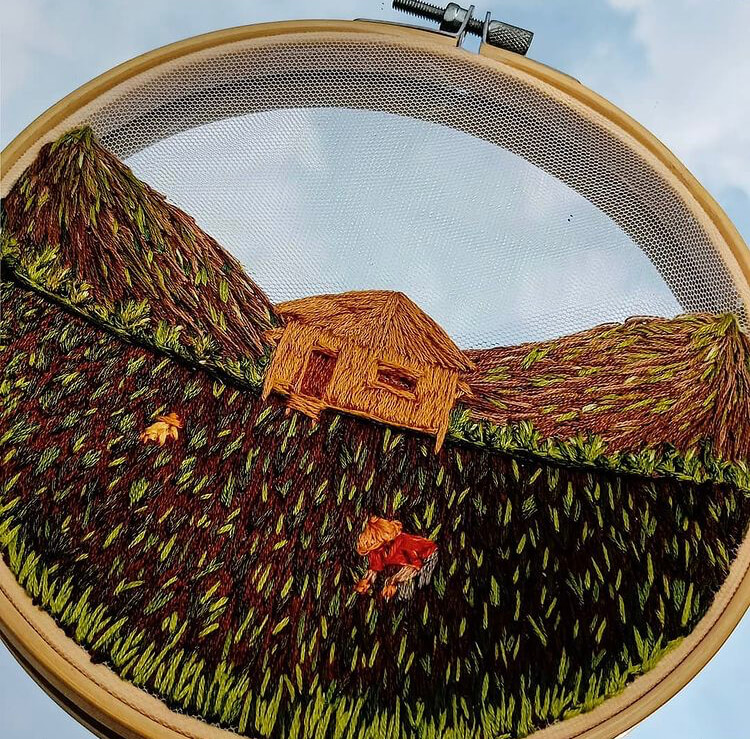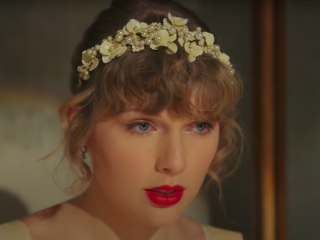During this mess of a year, many women turned to embroidery to combat the increased uncertainty that came with the pandemic. We talked to five embroidery artists about how embroidery helped them cope emotionally, and even financially, under lockdown.
Hiblahan
View this post on Instagram
Hiblahan’s works are centered around Philippine culture. “Embroidery helped me relax and kept my mind off things. It helped me focus on one thing at a time and reflect on my thoughts,” says Antonette Perez of Hiblahan. She adds that opening commissions back in April also helped her contribute to the bills at home.
Perez, the person behind the profile, made the Sierra Madre piece to express her frustrations after the onslaught of Typhoon Ulysses. “We know this mountain range protects us whenever there is a typhoon, yet people are still trying to destroy the very thing that keeps us safe,” says the 23-year-old.
Her work on the Sierra Madre piece is distinctive for its use of loose threads in her design. “It took me a while to come up with this but [I wanted to show] the idea that people are starting to slowly unravel the mountain range. If we do not try to make an effort to stop [the flattening of the mountains], they will be gone forever,” Antonette explains.
Eha.ph
View this post on Instagram
“In late 2017, I was beginning to heal from an emotional and psychological trauma. I needed an outlet. I wanted to share my story,” Miryam Tolentino says of how she started doing the craft. “At that time, I was already doing crochet as a hobby but I figured that embroidery would be a better medium if I wanted to send a message, since I can incorporate both words and images [in embroidery],” she adds.
The 20-year-old broadcast communications student says that she had only been out of her house five times at most since the lockdown was enforced in March. She reveals that while being stuck at home affected her mentally, embroidery became an outlet, a form of meditation. “I release the tension I’m feeling by creatively stabbing fabric with a needle. Embroidery helped me cope like it did three years ago. Moreover, since my works are focused on my advocacies, the time I spend on each work is my way of showing solidarity with people from different sectors who are especially affected by the pandemic. I keep in mind the situation of minorities and how we can create a better future with them, starting with rousing people, one stitch at a time,” she explains.
Sunlit Stitches
View this post on Instagram
Albien Sison, the artist behind Sunlit Stitches, began embroidery to relive memories. “Before the pandemic, I was really into the outdoors. The mountains were my favorite destination, and so I’ve accumulated a collection of photos and treasured memories from various hiking trips. During quarantine, I began painting and embroidering these photos as a way of reliving the memories,” she says. “That day was just really memorable, and I wanted to draw out the good times by using it as a reference for my work,” she says of her work.
According to Sison, who usually does mixed media art, her first love was painting so it made sense for her to paint on her embroidery. “Embroidery was initially a way to process overwhelming emotions that I couldn’t face in any other way or medium. I read books and painted during this time, too, but there’s just something relaxing about the repeated stitching motions and the sound of the needle and thread passing through fabric.”
Re Clothing
View this post on Instagram
Bianca Gregorio is the woman behind the secondhand clothing shop, Re Clothing. Gregorio sells upcycled clothes and re-designs them by adding hand embroidery.
Re Clothing originally started as a brand for curated secondhand street items, but after watching “The True Cost”, a documentary on fast fashion, Gregorio wanted to incorporate sustainability into her brand. “I wanted to find something that would upcycle these garments and provide them a wow factor to encourage more people to buy secondhand,” she explains.
Gregorio helped out with a lot of fundraisers by selling embroidery hoops. “It’s been able to help me feel better knowing my craft was able to help provide for people struggling during this time,” she says. “In the coming year, I’d like to be able to train people in my community who have been displaced by the pandemic. Ultimately, my hope is to help people the way embroidery has helped me,” she adds.
That’s So Cute
View this post on Instagram
“Embroidery saved me,” says Melissa Mayol, founder of Embroidery Enthusiasts.
Mayol recounts how embroidery gave her a purpose, “It kept me sane. It gave me a job. I earn more now because of it, and not just money but also friends and knowledge. It got me out of my comfort zone and now, I’m freer, happier and more empowered.”
Mayol founded Embroidery Enthusiasts to give back and promote the art through exhibits and workshops. “Now there’s a huge demand for handmade items in a world where machines dominate the production line,” the Cebuana artist points out. It’s easy to be distracted by devices, but it’s cool to “build stuff with your hands too,” she says.
Mayol organized heART in a hoop: A virtual embroidery art exhibit, where 20 embroidery artists (including those whose works have been featured here) contributed a total of 75 pieces in different genres.
View the exhibit until January 11 here.
Photo courtesy of Hiblahan
Related stories:
Siningtinta’s tattoo studio is now an art space for other women artists
Vania Romoff and Martin Bautista are moving forward with fashion
Selling face masks and supporting an Indigenous tribe—here’s how a fresh grad is doing it
These Filipino illustrators launched a font with native flora for a cause


